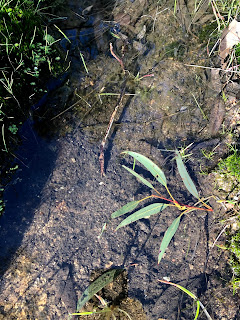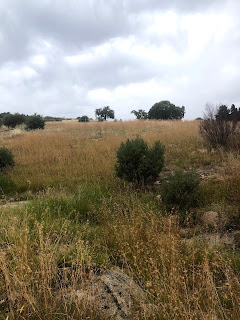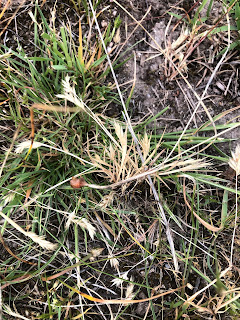Brrrrrrrrr! It's been a pretty cold and wet winter here at Pine Hill. We love the rain, of course, and our dams and tanks are full to overflowing, but it's starting to get a bit old now. Bring on spring!
This post will showcase our major creek rehabilitation project, funded with a grant from the local water management authority. It's a project that would have involved tree planting parties and working bees had COVID not shoved its snout in and stuffed everything up! So, it's just been me and Charles doing all the hard work, but actually it's turned out really well. There's nothing quite like planting in a beautiful quiet space with a running creek in the background to get your mind off the troubles of the world.
I've been putting videos and pictures up more regularly on our Facebook page - Pine Hill Equestrian - if that is something you're interested in. Apologies to those who have been following that because the images are reproduced here.
This photo shows the bottom half of our creek and you can see the fencing on either side. This area of creek does not run often - only after significant and consistent rainfall. You can't seek all the planting (yet!) but our hope is, once those grasses, bushes and trees start to take hold, the water table will be brought more consistently to the surface and the creek will run more regularly. Maybe even all year round!
You can see the young wattle tree growing in the left foreground. This was planted about 18 months ago and the pond you can see mid-picture is actually a large eroded area that may slowly fill in (or not!) as the creek recovers.
The big tree is actually two trees almost entwined - one a Blackwood (I've planted a heap of those now!), and the other a gum of some kind. These are the only large, mature native trees for at least 300 metres.
This is the new loafing area the clever Charles built. The water trough is installed here (not visible in this pic as it hadn't been installed when this was taken) and the horses already enjoy hanging around in here instead of on the pasture. Eventually, the 'back paddock' that is on the right of the picture, and is currently about 30 acres, will be divided into four paddocks connected to this loafing area. One paddock will hopefully produce hay, down the track.
The creek runs down the left of this shot, and you can see the big trees in the background. I have planted several trees around the loafing area and the pond though we are looking at shade options for the next few years while those trees grow.
This is the midway point of the creek and, as you can seek, a favourite area for the kids to play in - even in winter! The creek runs over large rocks and forms this little pool. There is always water in this pool, even in the height of summer.
I planted a lot of rushes, lillies, and a water-loving species of tea tree here to help slow and filter the water as it runs down the hill. There are always frogs and birds around here.
In the rocky surrounding areas, I planted various plants and grasses with some red gums and apple boxes. This place already looks so much healthier now the horses can't get into it and wreck it.
 |
| My office! |

This video and the two photos showcase the most beautiful part of our property. This is nearing the top of the creek area, where the water runs all the time - though often dips below ground level in summer.
 |
| Water so clear you can't see it! |
You can see how green and lush it is after a wet winter. I planted a lot of rushes, lillies and shrubs along the bank to help stabilise the banks and slow the speed of the water as it runs over rock. This area is already home to a lot of little creatures and hopefully the planting will help provided habitat for even more.
This photo shows one of the sites where we have placed dead branches and boughs to slow the water. This is an approach we have found really effective in mitigating erosion damage and helping the water spread and stay for longer. Without trees and plants holding the banks together (the grass has been great but can't withstand fast-flowing water for long), the banks would erode further. This also stops stock stepping in your watercourse if you haven't been able to fence it off yet.

The mosses on the right are just stunning and hold an incredible amount of water. You can see several species just in this small area. I've been working hard to protect mosses at our place, particularly on the big chunks of rock in the middle of soaks (ie areas where the water table is close to or at the surface/ground level).
 |
| Only 63 to go! This was my dumping site for the tube stock containers. 1000 plants all up. I can't believe I managed to get them all in! |
It has been absolutely fascinating to watch the performance of our pastures over the past three months. Given how wet it has been, I decided not to undertake any weed spraying so as not to contaminate our precious wet areas (half the farm becomes waterlogged at this time of year!). This is also in keeping with my belief that winter is a time of dormancy - for me as well as the land and animals. I don't think winter spraying is a good use of herbicide as nothing grows to replace the weeds at this time, except more weeds!
You'll notice the different species and colours of grass and plants in this photo. The larger green areas are capeweed, the long reddish grasses are red grass and the other grasses are various native and introduced species such as wallaby grass, kangaroo grass, cocksfoot, phalaris and clover. This is early winter and the grasses (and capeweed!) are much more lush now as this paddock gets very wet in winter. As a result, I decided not to put horses in it while it's so wet and the pasture is loving it.
My view on weeds has really crystallised over the past year. All weeds tell you something about your soil, and most weeds are only half bad. For example, flat weed and capeweed hold our soil together and provide a great habitat for worms. They LOVE the weeds! Over the past few years, as we have increased the pH of our soil, encouraged dung beetles and practiced rotational grazing, the weeds have decreased and the species of weed has changed. I will definitely have to attack the false radish (also called storks bill) this spring as it is very invasive, but the others I won't bother much with. Capeweed just dies off in the heat of summer and tends to be easily out-competed by grasses. Flatweed has really reduced now so I just ignore it.
Lastly, my beloved dung beetles. The pic below is of a big healthy
B. Bison boy that we captured in a trap at the beginning of winter. I was ecstatic to find him (and a few of his friends and family!) as this is a great sign that our dung beetle-friendly horse management program is working.
B. Bison is a wintering beetle that will remain active all winter, during manure up to 40cm below the surface and effectively conditioning our soil. Go little guy!
Unfortunately, as the fox scat on the left shows, our resident fox/es eat dung beetles. You can see in the bottom third of the picture the black body parts of the beetles in the grey remains of the scat. This is something to watch out for if you have an abundance of foxes. Just one more reason to work on controlling and eliminating feral animals.
And lastly, more evidence our management approach is really paying off. This picture is one I took when I moved a horse tyre feeder last week. See all those worms? They just weren't there two years ago. I recall planting trees and never seeing a worm in any of the holes I dug. Worms really do tell you how your soil is going and this seems to be a pretty big tick!










































